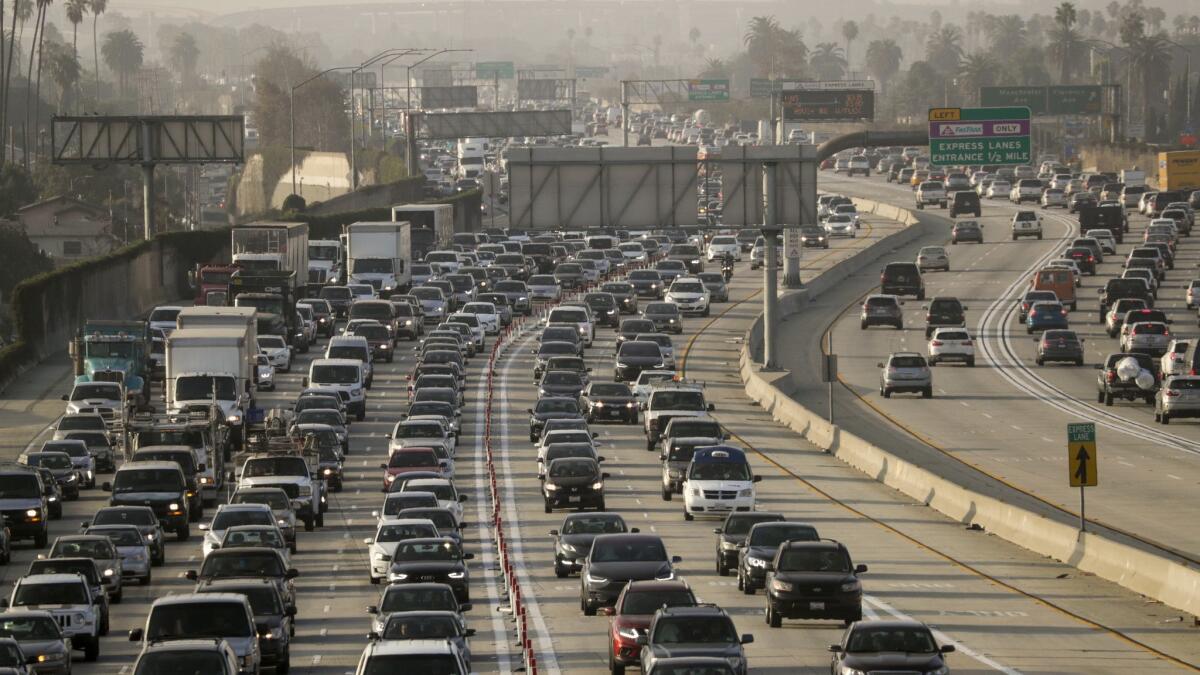Editorial: If you want to save mankind (or at least ease traffic) you’ve got to pay a toll

- Share via
It’s a widely held, even cherished, belief in California that freeways should be free. Free to drive on and free from traffic congestion.
Obviously, that belief doesn’t match the reality in Los Angeles. Take a look at any major highway during rush hour and you’ll see car after car inching along bumper-to-bumper. That congestion carries a staggering societal cost — to the environment, public health and productivity. And as bad as traffic is today, it’s projected to get far worse in the coming years as the region’s population and economy grow.
Southern California needs radical change to reduce traffic and slash the greenhouse gas emissions responsible for global warming. One radical solution is “congestion pricing”: charging people a fee to drive on the roads in certain areas during the most car-clogged times of the day. This has been done in London, Stockholm and other cities around the world.
Los Angeles County Metropolitan Transportation Authority CEO Phil Washington broached the idea last month of charging rush-hour tolls on drivers as part of a larger plan to raise billions of dollars to accelerate construction of major transportation projects for the 2028 Olympics. The fees would not only prompt more people to use public transit, carpool or avoid driving during rush hour, they could raise $12 billion to $52 billion over the next decade that could be used both for construction and to eliminate bus and train fares.
The question isn’t whether congestion pricing works, but whether it is fair.
Shockingly — given that congestion pricing has often been a third-rail idea in transportation politics — Metro board members were cautiously supportive of the concept. Washington has proposed that the board order a study of congestion pricing options and appoint an advisory council of experts to help shape a fair and effective tolling system.
Transportation experts say congestion pricing is the rare silver-bullet solution to excessive traffic. After London enacted a congestion charge to enter the city center in 2003, car traffic dropped by nearly 40% and travel speeds on the city’s streets increased. Stockholm’s congestion tax cut traffic and air pollution in heavily traveled areas. While Swedes were initially skeptical of the tax — polls showed some 70% opposed it before implementation — within a few years, public opinion flipped and 70% supported the tax.
The question isn’t whether congestion pricing works, but whether it is fair.
Fixed, per-vehicle tolls are regressive. Wealthier people can pay an extra $10 to $15 a day and get the benefit of faster drives, while lower-income people could be priced out of their cars. The challenge for Metro will be to develop a congestion pricing system that doesn’t penalize the poor or those who live in neighborhoods with poor transit service.
Congestion pricing is unworkable for rich and poor alike unless the affected area has a public transit system reliable enough to provide commuters a realistic alternative to driving. There are few places in Los Angeles now that have such a system — downtown L.A. might qualify — but there may be more in the future as Metro adds lines. Toll revenue could be used to lower fares and add buses and trains so it’s even cheaper and more convenient to take public transit. Or the money could provide subsidies for low-wage workers who drive into congestion pricing zones.
Another complaint is that congestion pricing forces drivers to pay twice. They already pay gas taxes and vehicle fees for road maintenance; a toll would be another fee to use a public asset they already paid for. But there’s nothing unusual about this arrangement. We pay an admission fee to use state and national parks, even though tax dollars maintain these areas. We feed the meter in order to park a car on a public street.
Enter the Fray: First takes on the news of the minute »
A car-clogged freeway is not functioning as designed. Congestion pricing helps get roads working again by encouraging would-be drivers to stay off during busy times. It’s a lot cheaper and easier than widening every freeway and road in Los Angeles — which would be practically impossible, not to mention incredibly expensive, disruptive and ultimately useless. Studies show that when a road is built or widened to ease congestion, it often persuades more people to drive, which results in similar or worse congestion than before the project.
Studies also show that greenhouse gas emissions worldwide are growing at a faster pace, making it much harder to prevent the most severe effects of climate change. In California, the transportation sector is the state’s largest source of greenhouse gases; people are driving more and emissions have risen despite the arrival of vehicles that burn less fuel per mile. It’s clear that radical steps are needed if the world has any hope of slowing climate change.
“We’re talking about saving mankind here,” Washington told a Metro board committee last week.
Even if congestion pricing alone doesn’t save mankind, it probably could save Los Angeles from smothering in traffic and air pollution. The unanswered question at this point is whether Metro can do it in a way that’s both effective and fair.
Follow the Opinion section on Twitter @latimesopinion and Facebook
More to Read
A cure for the common opinion
Get thought-provoking perspectives with our weekly newsletter.
You may occasionally receive promotional content from the Los Angeles Times.










